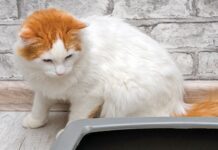Next to food, the litter pan is probably your kittys favorite possession. Like cats, litter boxes come in many styles, shapes, and prices: open, covered, sifting, and automatic pans. Each has its advantages and disadvantages, and before you go shopping keep in mind that your cat has his own list of litter box preferences. If you want litter box harmony, you best respect his likes and dislikes.
Your cats desires
Cats want plenty of room to move around, and large cats usually prefer open pans. Some are so inexpensive they can be tossed monthly rather than having to scrub them. If the cat is urinating right outside the box, especially if he is standing in it or digging in it, consider a bigger box, Tracy Kroll, DVM, an animal behavior resident at the Cornell University College of Veterinary Medicine, says. You can use an under-the-bed sweater-type box for a really large pan.
Shy cats may prefer covered boxes because they fear ambush by aggressive companions. Covered pans shield you from odors and from viewing kitty in the box. However, small covered boxes may not receive a warm reception from big guys. Also, odors trapped inside get a huge paws down. Cats dont want to use a smelly bathroom any more than you do. Some finicky cats might prefer electronic cat boxes that have an automatic cleaning device, keeping them perpetually clean.
Regardless of the box, if you use scoopable litter, avoid pans with sharp corners and channels along the bottom. They make it almost impossible to remove the clump without breaking it. These remaining small broken pieces will eventually begin to smell. Rounded corners cut down on this problem.
Once you have determined your cats needs, then you can decide what works for you.
Litter box options
Automatic boxes are the Rolls Royces of the cat toilet world. These receptacles have a substantial price tag, but they reduce the owners contact with waste and the amount of bending and lifting that must be done. Cats that refuse to use a dirty litter pan may love this type of box because their bathroom will reliably be clean. Many like to watch them work, too. Be aware, though, that some cats resist using automatic boxes, preferring instead the simpler alternatives.
The LitterMaid has a rake that sifts clumps into a plastic container. However, loose litter tends to fall on the floor between the container and the box. LitterMaid is about the size of a large open litter box.
The Litter-Robot is larger and more expensive than the LitterMaid, but it has a much larger storage area. Instead of a rake, the globe rotates and dumps the clumps into a tray that is lined with a plastic bag. Simply pull the tray out and turn the bag inside out to empty it. You never have to touch the clumps. Both the LitterMaid and the Litter-Robot work with clay-clumping or plant-based clumping litters.
There are other types of litter boxes that self-clean in various degrees. OmegaPaws Rollaway and Blitz USAs Litter Gitter require a little human assistance but cut down on the work involved in scooping the box.
Beyond the box
You bought the perfect box but kitty still misses the mark; take him to his veterinarian to be sure theres not a medical problem. If he checks out, the problem may be the litter. Most cats hate scented litter. With noses 100 times more sensitive than ours, a little scent is often too much.
There are many reasons for a cats avoiding using the litter box. Kroll gives a short list: The box is not clean enough, he dislikes the litter, it is in an area distasteful to the cat, or other cats are keeping him away. For problem kitties she suggests getting a new box, cleaning it more frequently, and making sure he likes the litter. Most cats prefer sand-like litter, a material most similar to the soil they would use in the wild.
There is enough variety in the litter box world to please everyone. Just remember that it is your cats box. Respect his preferences when you go shopping and youll both be happy.



